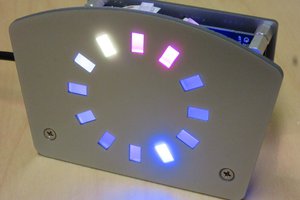In order to create this puzzle, I looked at a bunch of movie bombs. A surprising number of them rely on two chemicals that are in different clear containers, and as the timer counts down the two chemicals mix and change color, and then get released at the end unless defused. I thought that'd be pretty simple to emulate with a light in a bottle. They also have lots of electronics and wiring exposed, so I wanted to emulate that. At my local hackerspace Sector67 I rummaged through some bins of old PCBs and found a network switch or something; I'm not sure what it was but it had a bunch of serial ports and ethernet ports. I thought that I could wire them up so that attaching cables in the correct order would defuse the bomb.
The bomb is composed of the following:
* The motherboard PCB - this is modified with a hole drilled through to allow wires, then each of the network ports has a single airwire from one point to another in such an order that once the cables are plugged in the correct configuration, it completes a single circuit. Any other configuration doesn't complete it.
* Laser cut acrylic frame - a top and bottom piece to protect the electronics and act as an attachment mechanism for the rest of the parts. These are held together with a set of long bolts and nuts to keep each layer in place.
* Three different sizes of clear bottles. These are filled with a combination of water and white gatorade. I needed something partially opaque and white that would reflect the underlighting and appear to change colors, and the white gatorade is a perfect suspension for this. It's terrible to taste, and very sticky, though.
* Random clear hose. This was just threaded throughout but non-functional.
* A strip of WS2812 LEDs. Not all the LEDs were used, as I maintained the strip and just programmed the arduino to skip over the ones that were in the space between the bottles.
* An arduino uno. This was the main brains. It had one output for the LEDs, an input for the cables, and an input for the photoresistor. It also had a LCD shield on top for the display, and one output for a buzzer.
* A photoresistor. This was attached to part of the electronics outside. When the unit was first powered, it would look at the photoresistor, and if it's above a threshold of brightness, then it starts the timer. Otherwise it stays powered off and watching the photoresistor value. This way I could put the briefcase on top of the bomb and turn on the power, and it would stay off until the players moved the briefcase, and then it would be started at 30 minutes.
* A LOT of hot glue to seal all the caps (since they were all filled with fluid and upside down). Plus a lot to hold the LEDs in place.
I had to cut holes in most of the caps and then seal a clear plastic in the center of the cap so that the light from the LED would shine through. Unfortunately a couple of these had very slow leaks and after time the sticky gatorade got out and molded over the LEDs.
 Bob Baddeley
Bob Baddeley

 Tom Dowad
Tom Dowad
 Christoph Tack
Christoph Tack
 Jan
Jan
 Enrico
Enrico
White gatorade as a diffuser... new one to me, very creative!